Traditional warehouse are the foundation of the supply chain and have been an integral part of commerce for centuries. These facilities have evolved to suit changing technologies and business needs. In this comprehensive document, we’ll explore deep into the world of traditional warehouses, exploring their history, functions, characteristics, and their role in the modern supply chain.
- 1. Introduction to Traditional Warehouse
- 2. Historical Perspective
- 3. Functions of traditional warehouses
- 4. Features of traditional warehouses
- 5. Technology in traditional warehouses
- 6. Challenges faced by traditional warehouses
- 7. Modern Relevance of Traditional Warehouses
- 8. Conclusion
- Frequently Asked Questions
- What is a traditional warehouse?
- How does a traditional warehouse operate?
- What are the major functions of a traditional warehouse?
- What are the main challenges of traditional warehouses?
- How can I improve the efficiency of a traditional warehouse?
- What is the role of a warehouse management system (WMS) in traditional warehouses?
- How do traditional warehouses handle inventory tracking?
- What is the difference between a traditional warehouse and a modern, automated warehouse?
- Are traditional warehouses becoming obsolete in the age of e-commerce?
- What are some best practices for effectively managing a traditional warehouse?
- Can traditional warehouses be sustainable and eco-friendly?
- What are the cost considerations for traditional warehouse operations?
- What is the typical layout of a traditional warehouse?
1. Introduction to Traditional Warehouse
Traditional Warehouse, as a concept, dates back thousands of years, when merchants and traders used simple storage facilities to stock goods for sale or trade. The modern concept of traditional warehouses, as we understand them today, has come a long way. Traditional warehouses are central storage facilities that provide secure and organized space for goods to various industries. These warehouses are the foundation on which the supply chain is built, and their importance cannot be overstated.

2. Historical Perspective
The history of storage dates back to ancient civilizations. For example, in ancient Egypt, huge barns were used to store excess crops. Similarly, ancient Roman storehouses, often located near ports, served as centers for the storage and redistribution of goods. Over time, storage practices evolved as trade routes expanded and the need for safe storage increased.
During the Industrial Revolution in the 18th and 19th centuries, traditional warehouses became more standardized and organized. The arrival of steam power, improved transportation systems, and mechanized handling equipment further changed the storage industry.
However, significant changes occurred in storage in the 20th century. The introduction of modern inventory management techniques and the spread of global supply chains led to more sophisticated warehousing practices.
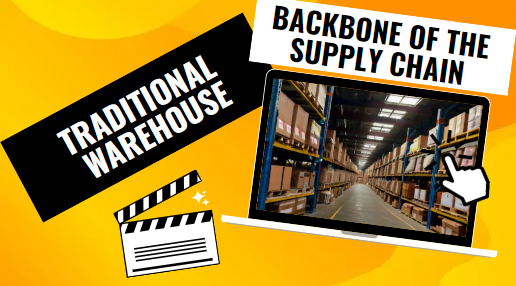
3. Functions of traditional warehouses
Traditional warehouses perform several important functions within the supply chain:
3.1. Storage
Traditional warehouses provide storage space for goods. They keep products safe, protected, and protected from external elements. This storage function allows businesses to maintain a supply of inventory, ensuring that products are readily available to meet customer demands.
3.2. Inventory management
Traditional warehouses play a vital role in inventory management. They help businesses keep track of stock levels, monitor product expiration dates, and manage order fulfillment efficiently. Modern inventory management systems and technologies have streamlined this function, enabling real-time tracking and optimization.
3.3. Order Complete
Traditional warehouses are responsible for picking, packing, and shipping orders. As orders arrive, warehouse staff locate the requested items, package them appropriately, and coordinate their dispatch. This work is critical to ensure timely delivery and meet customer expectations.
3.4. Consolidation
In the case of businesses that receive goods from multiple suppliers, traditional warehouses provide a platform for consolidation. Incoming shipments can be combined and organized before being sent to their final destinations. This consolidation process helps reduce shipping costs and increase efficiency.
3.5. Distribution
Traditional warehouses often serve as distribution centers, purposefully located to reduce transit times. They act as hubs for the onward movement of goods, whether to retailers, wholesalers, or directly to customers.
4. Features of traditional warehouses
Traditional warehouses exhibit several key characteristics:
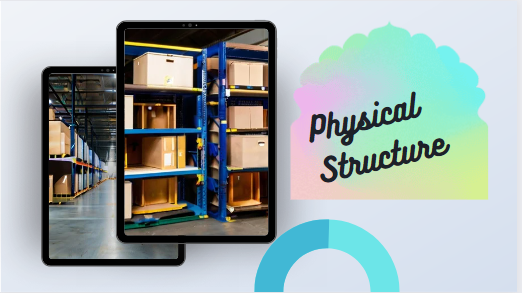
4.1. physical structure
Traditional warehouses are typically large, enclosed structures with strong walls and roofs designed to protect stored goods from external factors such as weather and theft. They can range from simple, single-story buildings to huge, multi-story complexes.
4.2. Place
The location of a traditional warehouse is important. They are often strategically located near transportation hubs such as ports, highways, or railways to facilitate efficient movement of goods.
4.3. Storage systems
Traditional warehouses are equipped with a variety of storage systems including racks, shelves, bins, and pallets to optimize space utilization. These systems enable organized storage and easy access to stored items.
4.4. Security
Security is a supreme concern for traditional warehouses. They employ various measures, such as access controls, surveillance cameras, and alarm systems, to protect goods from theft and unauthorized access.
4.5. Inventory management
Inventory management systems are an integral part of traditional warehouses. They use technology, barcoding, and computer systems to track merchandise from receipt to dispatch accurately.
4.6. Number of Employees
Traditional warehouses require a workforce to manage daily operations. This includes roles such as forklift operators, order pickers, packers, and supervisors. Labor is necessary for tasks such as loading and unloading trucks, maintaining inventory, and fulfilling orders.
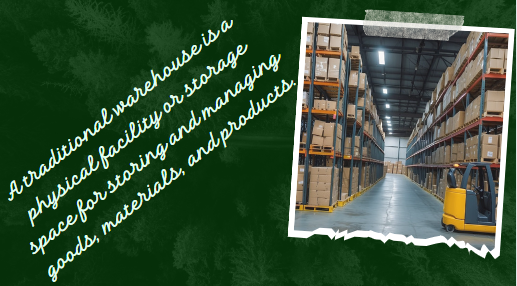
5. Technology in traditional warehouses
The arrival of technology has transformed traditional warehouses, increasing their efficiency and accuracy. Some major technological advancements include:
5.1. Warehouse Management System (WMS)
WMS software has transformed inventory management, optimizing warehousing, order taking, and tracking. It provides real-time visibility into inventory levels and order status.
5.2. Automated Content Management System
Automation in traditional warehouses includes conveyor systems, automated storage and retrieval systems (AS/RS), and robotic order pickers. These technologies improve speed and reduce errors in content handling.
5.3. RFID and barcode scanning
RFID (radio-frequency identification) and barcode scanning are used for quick and accurate tracking of inventory. They help streamline the picking and packing processes.
5.4. Data analysis
Data analytics tools are used to analyze warehouse performance, predict inventory requirements, and optimize operations. They provide valuable insights for decision-making.
5.5. Cloud-Based Solutions
Cloud-based solutions allow remote access to warehouse data and systems. This flexibility enables better coordination and management of operations from anywhere in the world.
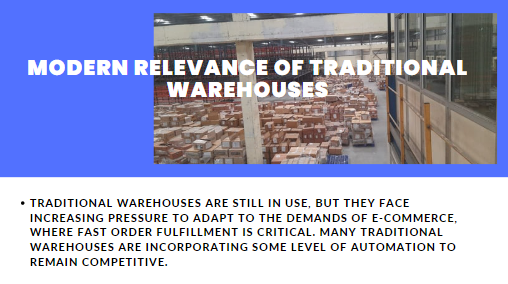
6. Challenges faced by traditional warehouses
Traditional warehouses, despite their long history and adaptability, face several challenges:
6.1. Labour shortage
Recruiting and retaining skilled warehouse workers can be a challenge. The physical demands of the job and the need for specialized skills make labor shortages a frequent issue.
6.2. Lack of space
As urban areas become more densely populated, finding suitable warehouse space is becoming increasingly challenging. Space constraints can limit the expansion and efficiency of traditional warehouses.
6.3. Technology integration
Integrating new technologies into existing warehouse operations can be complex and expensive. Careful planning and investment is required to ensure a smooth transition.
6.4. Security Risk
Traditional warehouses are vulnerable to security risks, including theft, vandalism, and cyber security threats. The security of valuable inventory and data is a constant concern.
6.5. Environmental effect
The environmental impact of traditional warehouses, including energy consumption and carbon emissions, is a growing concern. Many businesses are looking for eco-friendly solutions to reduce these impacts.
7. Modern Relevance of Traditional Warehouses
In the age of e-commerce, traditional warehouses have changed to meet the demands of online retail. E-commerce has brought changes such as faster order fulfillment, smaller order sizes, and an increased need for returns processing. Traditional warehouses have adapted by incorporating automation, optimizing the layout, and implementing advanced technology.
Moreover, the rebirth of local and small-scale manufacturing has also given a new lease of life to traditional warehouses. Small manufacturing operations require storage space for materials and finished goods, making traditional warehouses attractive.
The integration of Omni channel strategies has further highlighted the importance of traditional warehouses. Businesses need centralized hubs to efficiently fulfill orders across multiple sales channels, including physical stores, websites, and mobile apps.
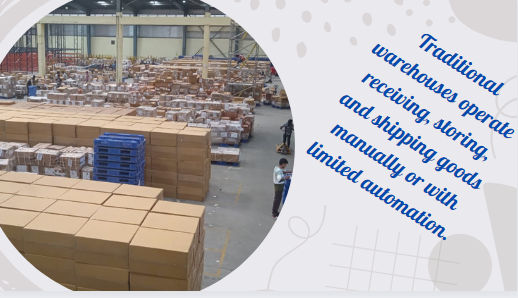
8. Conclusion
Traditional warehouses have a rich history and remain the backbone of the supply chain. Their operations have expanded and evolved due to technological advancements and changing business models. While they face various challenges including labor shortages and space constraints, traditional warehouses remain essential in a world driven by commerce and e-commerce.
Finally, traditional warehouses, though often taken for granted, are the unsung heroes of the modern supply chain. Their adaptability and flexibility ensure that goods flow efficiently from production to consumption, meeting the constantly changing needs of businesses and consumers. As technology continues to change, traditional warehouses will undoubtedly change with it, ensuring their continued relevance in the global economy.
Similar Topic: – Types of Warehouses
Frequently Asked Questions
What is a traditional warehouse?
A traditional warehouse is a physical facility or storage space for storing and managing goods, materials, and products. It generally follows traditional storage and distribution practices, relying on manual labor and basic technology.
How does a traditional warehouse operate?
Traditional warehouses operate receiving, storing, and shipping goods manually or with limited automation. They use forklifts, shelving, and pallets for storage and often rely on paper-based inventory management systems.
What are the major functions of a traditional warehouse?
The major functions of a traditional warehouse include receiving and inspecting incoming goods, storing products, picking and packing orders, and shipping products to customers or other destinations. It also includes managing inventory and ensuring proper organization within the warehouse.
What are the main challenges of traditional warehouses?
Traditional warehouses face challenges such as inefficient space utilization, high labor costs, errors in manual processes, inventory inaccuracies, and slow order fulfillment compared to more modern warehouse technologies.
How can I improve the efficiency of a traditional warehouse?
Efficiency in a traditional warehouse can be improved by implementing better inventory management systems, optimizing storage layout, training employees, reducing manual handling, and possibly introducing some level of automation.
What is the role of a warehouse management system (WMS) in traditional warehouses?
Warehouse management systems are software solutions that help in managing various warehouse operations. They can improve order accuracy, inventory control, and overall warehouse efficiency in traditional settings.
How do traditional warehouses handle inventory tracking?
Traditional warehouses often use manual methods such as periodic physical counts, barcoding, or RFID tagging to track inventory. These methods can be time-consuming and may lead to inconsistencies.
What is the difference between a traditional warehouse and a modern, automated warehouse?
Traditional warehouses rely on manual labor and have limited automation, while modern, automated warehouses use advanced technologies such as robotics, conveyor systems, and automated storage and retrieval systems (AS/RS) to streamline operations and reduce human intervention. Let’s take advantage of it.
Are traditional warehouses becoming obsolete in the age of e-commerce?
Traditional warehouses are still in use, but they face increasing pressure to adapt to the demands of e-commerce, where fast order fulfillment is critical. Many traditional warehouses are incorporating some level of automation to remain competitive.
What are some best practices for effectively managing a traditional warehouse?
Best practices for managing a traditional warehouse include regular inventory audits, staff training, efficient slotting of products, optimizing pick routes, and implementing safety protocols to ensure a safe work environment.
Can traditional warehouses be sustainable and eco-friendly?
Traditional warehouses can adopt eco-friendly practices by optimizing energy use, improving waste management, and exploring green building designs and technologies.
What are the cost considerations for traditional warehouse operations?
Traditional warehouse costs include labor, rent, or ownership expenses for the facility, utilities, equipment maintenance, and transportation. Managing and reducing these costs is important for profitability.
What is the typical layout of a traditional warehouse?
Traditional warehouses typically have a layout that includes receiving areas, storage racks or shelving, picking and packing areas, and shipping docks. The layout may vary depending on the specific needs of the business.
